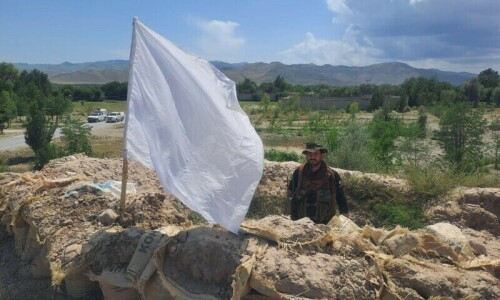"It was the best of times, it was the worst of times.”
If and when historians decide to chronicle the current rollercoaster upheavals in Pakistan, this Dickensian quote could serve as one of the most suitable opening lines, especially when it comes to our higher judiciary’s inconsistent decisions. These have, unwittingly, added to the uncertainty, chewing off the precious little public confidence left in the system.
Most people think the current judicial imbroglio dates back to the time when the Supreme Court, in the dead of night, decided to issue directions to the Speaker of the National Assembly to conduct voting on the no-confidence motion against the then prime minister Imran Khan.
In reality, the crisis owes its origins to the hitherto papered over fissures — now quite apparent to even a bystander — when Justice Qazi Faez Isa and his family were unfairly and unnecessarily grilled and harassed over concocted charges by the court itself, unleashing a vicious and relentless media trial.
The higher judiciary’s inconsistent decisions have led to an erosion of public confidence in the system and put Pakistan on the cusp of a perfect judicial storm… yet again
TWO JUDGES, TWO TREATMENTS
Incidentally, the same venom appeared to be conspicuously absent, comparatively speaking, when title deeds of a Lahore mansion worth almost a billion rupees were splashed all over social media with the picture and name on the documents appearing to be quite unmistakably that of a sitting Supreme Court judge. The same judge was allegedly recorded having a ‘friendly’ conversation with Chaudhry Pervaiz Elahi, while he was the chief minister of Punjab.
Further, it cannot be a mere coincidence that, whereas media coverage was not stopped in Justice Isa’s case — some say deliberately and by design — the Pakistan Electronic Media Regulatory Authority (Pemra) was quick to slap a ban on the ‘speculations’ and unsubstantiated rumours being spread in the media about the other judge. It goes without saying that, without a reliable forensic test of the audios and videos circulating on the media, whatever is inferred from those are mere allegations.
It is interesting to note that references filed in the latter’s regard have neither been entertained by the Supreme Judicial Council so far, nor has there been any prompt direction issued to the Federal Board of Revenue (FBR) to start a hounding operation, as happened, we might recall, in the former case. Although the news of rifts between judges has been a recurring theme in our judicial history, the present ominously calamitous course may be a new low since 1997.
JUSTICE SHAH DEJA VU?
The last time things reached lower was in 1997, in the case of Chief Justice Sajjad Ali Shah. When the shy-natured chief justice — as per his own autobiography titled Law Courts in a Glass House — unilaterally decided to invent his own brand of judicial activism, suspending constitutional amendments no less, the reservations of his brother judges soon transformed into an open revolt.
That sordid episode, which led to his ouster through orders passed by his own peers, is something any civilised society would like to forget in a hurry and move on.
Chief Justice Shah was imbued with a sense of patriotism and wanted to reform the system while occupying a top position — a phenomenon quite peculiar to Pakistan, where a one-window solution through a messiah-like figure is preferred over laying the foundations of a sustainable system which has the capacity to deliver almost by default. But in his enthusiasm to correct all the wrongs with one stroke, he conveniently forgot the limits to his powers, almost the same way a military dictator would react.
All in good faith.
The current divisions in the Supreme Court are ominously pointing towards the same ending, witnessed by most of us in 1997 which, in turn, begs the question: how many inches have we crawled forward in terms of institution-building, if at all! The answer: zero.
The crucial difference between 1997 and 2023 is that it was relatively easy for his brother judges to oust CJP Sajjad Ali Shah, because his own appointment fell foul of the Al-Jihad Trust case, which had laid out the principle of seniority in appointments to the position of CJP and of which Justice Shah was himself an author. In 2023, things are much more complicated.
There is no such ammunition available to either side this time around. Judges on both sides of the divide know this and have dug in for the ultimate battle, which might provide the textbook catalyst for an apocalyptic meltdown of the state. One can only hope that things don’t reach such a stage!
THE QUEST FOR LEGISLATIVE SOVEREIGNTY
Pakistani society’s struggle for legislative sovereignty for its parliament spans a few decades. Although the mediaeval instincts of believing in an absolute monarch or an authoritarian figure like a colonial master have been hard to shake off, the march towards reaching the goal of a republic has steadily proceeded since 1947.
It has to be said that the break from the past and the acceptance of the modern idea of a state have been resolutely resisted by direct military rule and by forces propped up and unleashed by it.
Notions of the ancien regime and Bonapartism have been the ascendant theme in Pakistan too, if one were to get insight from historian Simon Schama’s brilliant work Citizens, which captures the French people’s epic struggle to become a republic. That too was triggered, amongst other things, by food shortages and the ruling elite failing to sense the prevailing street sentiment.
If the dynamics and events of the French Revolution and its cataclysmic aftermath carry any abiding lessons for present day Pakistan, the elite-captured country hardly seems to be mindful of those.
It is quite clear that the judicial elite (read most chief justices in living memory) seems more interested in holding on to its powers to form favourable benches, with a view to bringing about certain outcomes — be it the Supreme Court rewriting the Constitution while interpreting Article 63A, or the Lahore High Court acting like a litigant before Imran Khan, and not vice versa, for instance.
Add to that the disturbing optics of administrative circulars overruling judicial pronouncements and a nine member bench of the Supreme Court getting whittled down to three, and you reach the cusp of a perfect judicial storm.
To most commentators, the current uncertainty in an already fragile economy has already jeopardised the political viability of the state. At the same time, one cannot ignore the behind-the-scenes workings of our very own peculiar brand of Bonapartism.
As the financial crunch grows more severe, in part due to the lack of certainty surrounding the International Monetary Fund (IMF) deal, the rich elite, it seems, are content at having their cake while remaining mired in their turf wars. The have-nots, on the other hand, may not have any other option remaining in the coming weeks and months other than to join the almighty rampage to get their share of the bread. Is anyone heeding the brewing storm?
Tariq Bashir is a Lahore-based lawyer.
He tweets @Tariq_Bashir and can be reached at tariqbashir16@gmail.com
Published in Dawn, EOS, April 16th, 2023















































Dear visitor, the comments section is undergoing an overhaul and will return soon.